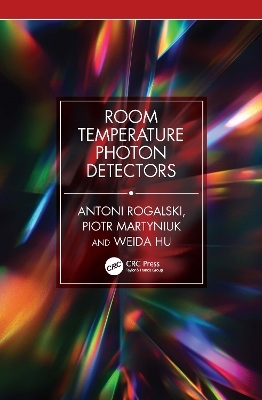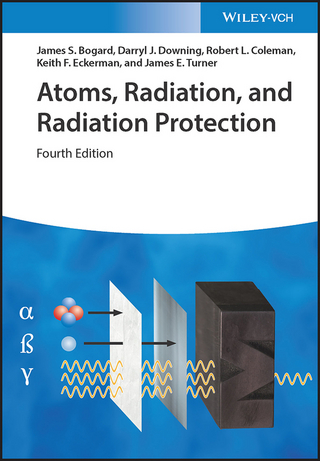
Room Temperature Photon Detectors
CRC Press (Verlag)
978-1-032-74571-8 (ISBN)
- Noch nicht erschienen (ca. Mai 2025)
- Versandkostenfrei innerhalb Deutschlands
- Auch auf Rechnung
- Verfügbarkeit in der Filiale vor Ort prüfen
- Artikel merken
Room Temperature Photon Detectors provides an overview of the performance of emerging new generation of room temperature photodetectors generally called low-dimensional solid (LDS) photodetectors among which the most important are two-dimensional (2D) materials, perovskites, and quantum dots (QDs)/nanowires (NWs) operating in a wide spectral range from the ultraviolet (UV), visible (VIS), far infrared (FIR) to terahertz (THz). The LDS reported performance at room temperature is even better than that presented for standard commercial photodetectors.
This book describes the peculiarities of the physical properties of LDS materials and their impact on the photodetectors’ performance. It also undertakes a comprehensive analysis of these performances when confronted with the standard photodetectors dominating the global market.
Currently, intensive efforts are being made to reduce the cost of imaging systems and, in particular in the infrared (IR) range, to increase their operating temperature by reducing size, weight and power consumption (SWaP). This raises the question of whether the emergence of a new generation of LDS photodetectors will result in their rapid commercialization and serious competition for the standardized bulk photodetectors. This book attempts to answer those issues/questions.
Features
• Defines the importance of LDS photodetectors in the broad group of standard UV, VIS, IR, and THz photodetectors, and includes their advantages/disadvantages
• Covers different types of photodetectors, including the relevant aspects of theory, types of materials, their physical properties, and detector fabrication
• Provides invaluable resource for graduate students in physics and engineering, as well as a guide for those already working with sensors and systems, thermal imaging, remote sensing, optical telecommunications, and light detection.
Antoni Rogalski is a professor at the Institute of Applied Physics, Military University of Technology in Warsaw, Poland. He is one of the world’s leading researchers in the field of infrared (IR) optoelectronics. He has made pioneering contributions in the areas of theory, design, and technology of different types of IR detectors. In 1997, Professor Rogalski received an award from the Foundation for Polish Science for his achievements in the study of ternary alloy systems for infrared detectors. Professor Rogalski is an active member of the international technical community – member of the editorial boards of several international journals; chair and co-chair, organizer, and member of scientific committees of many national and international conferences on optoelectronic devices and materials sciences. In 2022, he was awarded the Commander's Cross of the Order of Polonia Restituta by the President of the Republic of Poland. Weida Hu is currently the head of the State Key Laboratory of Infrared Physics and a full professor (Principal Investigator) at the Shanghai Institute of Technical Physics, Chinese Academy of Sciences, where he focuses on the fabrication and characterization of infrared photodetectors, photodiodes, phototransistors, and their smart chips. His papers have been recognized as one of "China's Top Ten Optics Advances" three times and one of "China's Top Ten Semiconductor Research Advances" twice. Professor Hu has been selected as the National Science Fund for Distinguished Young Scholars in 2017, the China Youth Science and Technology Award in 2019, the Royal Society-Newton Advanced Fellowship of UK in 2017. He serves on the Editorial Advisory Board of Small, as the Associate Editor of Infrared Physics & Technology, the Executive Editor of Optical and Quantum Electronics, the chair of the Optoelectronic Devices Committee of the IEEE Electron Devices Society, amongst others. Piotr Martyniuk has been holding professor position at Institute of Applied Physics, Military University of Technology (MUT) in Warsaw where he has been leading the Solid State Physics Department. He closely cooperates with KIND Lab in Ohio State University (OSU), Microelectronics Research Group in The University of Western Australia and Graduate Institute of Photonics and Optoelectronics, amongst others. Within his research activities he was awarded by the Polish Academy of Science - Dean of Division Four: Engineering Sciences for the research on the “Barrier IR detectors as a new generation HOT sensors” (2016). He was awarded by Minister of Defense (President of Republic of Poland honourable patronage) for the best completed project within the defense area “ HOT IR detectors with short response time” (2017). In 2021 he was awarded with 10 months Fulbright scholarship in OSU, KIND Laboratory. Since 2022 he has been holding a Visiting Professor position at SITP where he has been dealing mostly with APDs and SPDs. The main subject of his research is AIIBVI - HgCdTe, AIIIBV InAsSb and T2SLs IR detectors.
Preface
1. Optical detector characterization
2. Focal plane arrays
3. Ultraviolet photodetectors
4. Visible photodetectors
5. HOT infrared detectors
6. Room temperature direct terahertz detectors
7. Avalanche photodiodes from bulk to 2D materials
Index
| Erscheint lt. Verlag | 1.5.2025 |
|---|---|
| Zusatzinfo | 50 Tables, black and white; 41 Line drawings, color; 296 Line drawings, black and white; 8 Halftones, color; 39 Halftones, black and white; 45 Illustrations, color; 339 Illustrations, black and white |
| Verlagsort | London |
| Sprache | englisch |
| Maße | 178 x 254 mm |
| Themenwelt | Naturwissenschaften ► Physik / Astronomie ► Angewandte Physik |
| Naturwissenschaften ► Physik / Astronomie ► Optik | |
| Technik ► Maschinenbau | |
| ISBN-10 | 1-032-74571-1 / 1032745711 |
| ISBN-13 | 978-1-032-74571-8 / 9781032745718 |
| Zustand | Neuware |
| Informationen gemäß Produktsicherheitsverordnung (GPSR) | |
| Haben Sie eine Frage zum Produkt? |
aus dem Bereich


